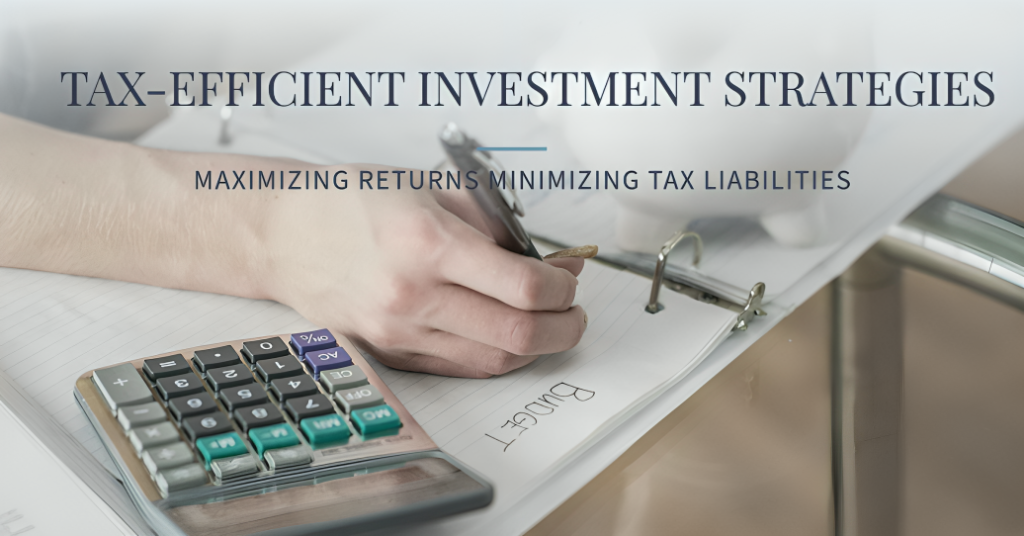In today intricate financial landscape. The art of investing wisely involves not only earning high returns but also skillfully navigating the labyrinth of taxes that can impact investment gains. Tax efficient investment strategies are the guiding beacons in this complex terrain. allowing investors to optimise their after tax returns while adhering to legal tax frameworks.
This article aims to help you understand tax efficient investment Strategies. We explore why it’s important and explain the main parts that help individuals and businesses make smart investment choices.
Importance of Tax Efficiency Investment Strategies

Navigating today’s complex financial landscape is like conducting a symphony of earning and taxes.. The harmony between these two elements defines the success of an investment venture. Tax-efficient investment strategies serve as the conductor of this symphony orchestrating movements that yield optimal returns while minimising the toll of taxes.
Maximising Returns Within Legal Boundaries
Investors are duty bound to adhere to the legal frameworks that govern taxation. Tax-efficient investment strategies provide a roadmap to navigate these frameworks meticulously. By executing these strategies with precision investors can find the sweet spot where they maximise their returns while staying well within the confines of the law.
Tax Efficient Investment Strategies: Unveiling the Essence
Tax-efficient investment strategies are like a finely crafted watch each component serves a purpose contributing to the overall precision. These strategies meticulously designed ensure that investment choices align seamlessly with tax laws.
This alignment in turn maximises the post-tax profits for investors. The key to unlocking this efficiency lies in careful planning and meticulous execution.
Tax Loss Harvesting: Sculpting Gains from Losses
One of the prized techniques in the realm of tax efficiency is tax loss harvesting. This masterful tactic involves the strategic selling of investments that have faced depreciation. The purpose? To balance out capital gains derived from other investments. This artful maneuver serves a dual purpose: it not only mitigates tax obligations but also restructures the investment portfolio in a tax-effective manner.
Strategic Asset Location: Where Every Asset Finds Its Place
Think of your investment portfolio as a puzzle. Strategic asset location is the art of fitting each piece perfectly to minimise tax leakage. High-tax investments such as bonds or high dividend stocks find their sanctuary in tax advantaged retirement accounts like IRAs or 401(k)s. On the flip side long term growth instruments like stocks thrive in taxable brokerage accounts, capitalising on favorable capital gains tax rates.
The Symphony of Asset Allocation: Risk Return and Tax
Allocating assets strategically is like crafting a harmonious symphony. where each note resonates with purpose. Diversifying investments across asset classes like equities bonds and real estate optimises the portfolio risk and return profile. This virtuoso maneuver not only enhances the portfolio financial symphony but also considers the tax implications ensuring that every note is tax-efficiently played.
Collection of Tax Efficient Investment Funds
Much like a virtuoso musician curates their instrument collection. investors can curate their investment funds for tax efficiency. Certain investment fund types such as index funds and ETFs perform like well tuned instruments. Their secret lies in generating fewer taxable events compared to their actively managed counterparts. Their strategy of mirroring market indices and maintaining low security turnover makes them stars of the tax efficient ensemble.
Balancing Act: Tax Efficiency Risk and Return
While tax efficiency is the spotlight of this performance the stage isn’t complete without the balancing act that involves risk and return. Investors must remember that tax efficiency though pivotal is just one note in the symphony. Each investment choice must harmonise with the investor’s risk tolerance and desired returns. Striking the perfect chord between these elements yields a well rounded investment strategy.
Professional Guidance
Navigating the complexities of taxation and investment requires a maestro’s touch. As tax laws and regulations dance like ephemeral notes, seeking professional advice is paramount. Engaging a qualified tax professional or financial advisor such as WSPTAX part of IBISS and Co can orchestrate a personalised financial symphony. These experts not only harmonise tax-efficient investment strategies but also tailor them to resonate with individual financial symphonies.
Conclusion
In the grand opus of investment tax efficient strategies compose an enchanting melody that harmonises tax optimization with wealth accumulation. Through tax loss harvesting strategic asset location and a well orchestrated ensemble of tax efficient funds investors create a symphony of financial success. As the curtain falls remember that while tax efficiency is a virtuoso performance the pursuit of your unique financial goals is the true crescendo. So embark on this journey with knowledge strategy and the guidance of professionals and compose your financial masterpiece.
FAQs
While efficient investment strategies cannot eliminate taxes on investment gains, they can significantly minimise the tax burden. Investors can optimise their after-tax returns and reduce their overall tax liabilities by employing asset location, tax-efficient funds, and tax loss harvesting techniques.
No, better investment strategies apply to investors of all income levels. While high-net-worth individuals may have more complex investment portfolios, individuals with smaller investment portfolios can still benefit from tax-efficient strategies. All investors must consider the tax implications of their investment decisions and seek opportunities to minimise taxes.
It is recommended to regularly review and adjust these strategies especially when there are changes in tax laws or personal circumstances. Additionally, annual portfolio rebalancing and tax planning sessions can help ensure the strategies align with your financial goals and evolving tax regulations.
Yes, tax-efficient investment strategies can be applied to both stocks and bonds. The principles of tax-efficient investing. Like asset location, diversification, and tax loss harvesting, can be implemented across various asset classes to optimise tax efficiency.









